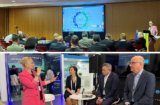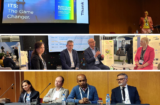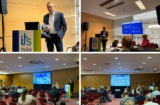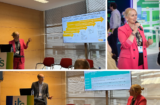- TM2.0
- TM2.0 Task Forces
- News
- Events
- Blog
- Library
- Members
- Contact Us
Highlights from TM 2.0’s participation in the ITS European Congress 2023
ERTICO’s Innovation Platform TM 2.0 had a great presence at the 15th ITS European Congress. This year, the ITS European Congress, organised by ERTICO, was hosted by the City of Lisbon from 22 to 24 May under the theme “ITS: The Game Changer”, highlighting the important role of ITS developments and technologies in answering societal and environmental needs. TM 2.0 was actively involved in a good number of Special Interest Sessions (SIS), a dedicated Side Event, and a discussion held with a small panel at the ERTICO stand.
Right at the start of the Congress, TM 2.0 and its coopetition concept were discussed at SIS 47 ‘Deployment: traffic management and stakeholder coopetition’. Moderated by Dr Johanna Tzanidaki, TM 2.0 Co-Chair and ERTICO Chief Innovation Officer, the session examined the deployment of the concept of coopetition in interactive traffic management, which relies on trust between all stakeholders, including public authorities and service providers, who cooperate while still competing. Members of the TM 2.0 platform presented their deployment Use Cases of TM 2.0 and discussed challenges and opportunities. Pedro Barradas (ARMIS), Dr Laura Coconea (SWARCO), Dr Bart Lannoo (Be-Mobile), and Irfan Shaffi (Transport for London), provided their insights and gave concrete examples of coopetition and data sharing as implemented by their own organisations. Their short presentations were followed by an interactive discussion with the audience on how public authorities can incentivise competitors to work together, how the needs and interests of the private sector can be taken into account in traffic management schemes implementing the TM 2.0 concept of coopetition and on the win-win-win business models in deployment.
Also on the first day of the Congress TM 2.0 organised and moderated the discussion in SIS 56 ‘The mobility network: MaaS and us’. Dr Johanna Tzanidaki moderated the discussion, which explored the links between the TM 2.0 platform and Mobility as a Service (MaaS), and how the need for user-centric mobility services that are tailored to individual needs, and the need for transport systems to manage traffic flows smoothly and efficiently can be reconciled and balanced in the Multimodal Mobility Network. The Session opened with the keynote speech of Petra Soderqvist (European Commission), who discussed the plans and policy initiatives of the European Commission in the field of Urban Mobility and the legal initiatives of MMTIS and MDMS. The speakers presented the viewpoints and approach from the public sector (Martin Russ from AustriaTech) and the private sector (Jop Spoelstra from Technolution) and also from the point of view of the MaaS Alliance (Roelof Hellemans). The audience had the opportunity to interact with the panel and discuss the exchange of data with the aim of having visibility towards the mobility network as a whole so that accessibility and liveability of cities is achieved for all. The panellists agreed that managing mobility flows should be based on information about the mobility demand while the needs of all stakeholders should be addressed at all levels and in all modes involved.
TM 2.0 kicked off the second day of the Congress with a Side Event in which Dr Johanna Tzanidaki reported on the Levels of Cooperation between Public and Private Stakeholders under the concept of TM 2.0, as these have been agreed at the TM 2.0 Workshop held in Brussels in February. European Commission representatives also joined this Side Event with keynote speeches. Mr Torsten Klimke, Head of Unit at DG MOVE, gave a short presentation on the latest update of the European Urban Mobility Framework and the policy developments linked to traffic management at EU level while he also explained the work being undertaken by the Expert Group on Urban Mobility (EGUM), in which ERTICO is leading the sub-group on ‘Space management and the future of mobility’. Mr Sergio Escriba, Head of Sector Automated Transport at CINEA, then provided an overview of traffic management projects that have been (and are being) funded by CINEA while he also shared information on future and currently available funding opportunities in this field. The Side Event closed with an overview of the programme of the 4th International Symposium on Traffic management (ISFO) which is planned to take place on 26-30 June in Vienna, and which is being organised with the active support of the TM 2.0. Dr Johanna Tzanidaki reminded everyone that it is at the ISFO Symposium in Vienna that TM 2.0 will be holding its annual General Assembly this year (26 June, 13:15-15:15).
Following the Side Event on the second day of the ITS Congress, three TM 2.0 members, Martin Russ from AustriaTech, Dr Laura Coconea from SWARCO, and Paul van Koningsbruggen from Technolution, shared their views on ‘Public Transport’ with short presentations and a discussion on the necessity of its integration into traffic management and urban planning. The discussion took place at the ERTICO Stand in the Congress exhibition area. The discussion was moderated by Dr Johanna Tzanidaki.
Later on the same day, the TM 2.0 Task Force on AI organised (Carolien Mazal from TomTom) and moderated (Dr Johanna Tzanidaki) SIS 22 on ‘How far is ‘High Risk’ AI used in Traffic Management’. The panel showcased how AI is currently used as a tool aiding and supporting decision-making in the process of Traffic Management operations and discussed how the decision-making chain in traffic management works from the perspective of road operators by Fabrizio Paoletti (Autostrade per l’Italia) and from the perspective of Service Providers and Traffic Industry by Dr Bart Lanoo (Be-Mobile), Carolien Mazal (TomTom), Luca Paone (PTV), Franz Schober (Yunex Traffic), Torben Titze (SWARCO). Jorgen Bundgaard Wanscher (Hermes Traffic Intelligence) discussed the concept of decision chain and the data driven decision support and how this may evolve in the future. The Session collected input from the audience which had a great interactive exchange with the panel. This input will be the basis of the feedback that the TM 2.0 Task Force will be submitting to the European Commission on the drafting of the Guidelines that will support the EU AI Act.
During the last Sessions timeslot of the second Congress day, TM 2.0 member Be-Mobile (Evert Gellynck) organised SIS 39 on ‘Public-Private cooperation enables disruptive multi-domain traffic centres’. The session, moderated by Dr Johanna Tzanidaki, presented an interesting alternative to the traditional traffic management schemes and discussed traffic management as a Service (TMaaS) and how this is running the 3rd year of implementation in the region of North Holland in the Netherlands. Claudia Snel (ARCADIS), Mark Grefhorst (Be-Mobile), and Andre Loos (Region of North Holland) explained how the public-private cooperation created a disruptive, yet perfectly functional traffic management operational scheme while Irfan Shaffi (Transport for London) commented from the point of view of a metropolitan city traffic management operator. The discussion with the audience clarified important aspects with regard to both technology and governance on the topic of multi-domain control centres.
TM 2.0 member TomTom organised SIS 45 on the third and final day of the Congress. The Session focused on ‘The ITS Stories from the War in Ukraine’ and discussed how the City of Kyiv (Perto Olenych) has transformed its transport app into a life-saving tool for its citizens. Stephanie Leonard from TomTom and Georgii Sokolianskyi from Uber shared with the audience information about their efforts to guide people to safety and even out of the country. Dr Johanna Tzanidaki and Stephanie Leonard co-moderated that (at times) emotional discussion with the audience, which had the opportunity to ask details on the operational aspects of how ITS tools have supported the safety of citizens in the war zones of Ukraine.
Over the three days of the ITS European Congress, TM 2.0 and its members organised and participated in a total of five Special Interest Sessions, held a Side Event and a panel discussion at the ERTICO stand, demonstrating TM 2.0’s commitment to driving the future of interactive Traffic Management while bringing together and facilitating the dialogue between public authorities and service providers in Europe.
 ERTICO Partnership Activities We use cookies on our website to give you the most relevant experience by remembering your preferences and repeat visits. By clicking “Accept”, you consent to the use of ALL the cookies. However you may visit Cookie Settings to provide a controlled consent.Manage consent
ERTICO Partnership Activities We use cookies on our website to give you the most relevant experience by remembering your preferences and repeat visits. By clicking “Accept”, you consent to the use of ALL the cookies. However you may visit Cookie Settings to provide a controlled consent.Manage consentPrivacy Overview
This website uses cookies to improve your experience while you navigate through the website. Out of these, the cookies that are categorized as necessary are stored on your browser as they are essential for the working of basic functionalities of the website. We also use third-party cookies that help us analyze and understand how you use this website. These cookies will be stored in your browser only with your consent. You also have the option to opt-out of these cookies. But opting out of some of these cookies may affect your browsing experience.Necessary cookies are absolutely essential for the website to function properly. These cookies ensure basic functionalities and security features of the website, anonymously.
Cookie Duration Description cookielawinfo-checbox-analytics 11 months This cookie is set by GDPR Cookie Consent plugin. The cookie is used to store the user consent for the cookies in the category "Analytics". cookielawinfo-checbox-functional 11 months The cookie is set by GDPR cookie consent to record the user consent for the cookies in the category "Functional". cookielawinfo-checbox-others 11 months This cookie is set by GDPR Cookie Consent plugin. The cookie is used to store the user consent for the cookies in the category "Other. cookielawinfo-checkbox-necessary 11 months This cookie is set by GDPR Cookie Consent plugin. The cookies is used to store the user consent for the cookies in the category "Necessary". cookielawinfo-checkbox-performance 11 months This cookie is set by GDPR Cookie Consent plugin. The cookie is used to store the user consent for the cookies in the category "Performance". viewed_cookie_policy 11 months The cookie is set by the GDPR Cookie Consent plugin and is used to store whether or not user has consented to the use of cookies. It does not store any personal data. Functional cookies help to perform certain functionalities like sharing the content of the website on social media platforms, collect feedbacks, and other third-party features.
Performance cookies are used to understand and analyze the key performance indexes of the website which helps in delivering a better user experience for the visitors.
Analytical cookies are used to understand how visitors interact with the website. These cookies help provide information on metrics the number of visitors, bounce rate, traffic source, etc.
- Events









